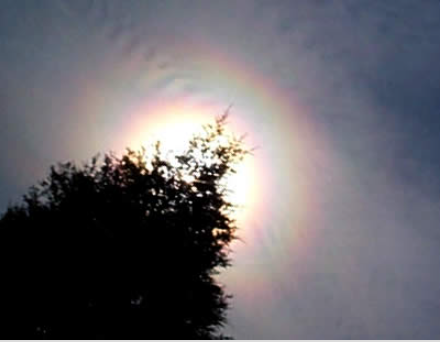Corona around the sun
Corona Around the Sun: A Phenomenon of Light
When we look up at the sky, we often witness breathtaking displays of light and color. One such spectacle is the corona around the sun, a fascinating atmospheric optics phenomenon. This ethereal phenomenon occurs when sunlight interacts with tiny water droplets or ice crystals in the atmosphere. While the existing content provided a glimpse into this captivating event, let's delve deeper and explore the intricacies of the corona around the sun.
The Science Behind the Corona
The corona around the sun arises due to diffraction and interference of sunlight as it passes through cloud droplets or ice crystals suspended in the atmosphere. These particles act as miniature prisms, bending and scattering the incoming light. As a result, the light waves interfere with each other, creating rings of varying colors around the sun.
The Role of Droplet Sizes
One intriguing aspect of the corona is that the visibility of its rings depends on the uniformity of droplet sizes. When cloud droplets have similar diameters, as indicated by the presence of a second ring, the corona appears more intense and distinct. However, even a slight variation in drop sizes can diminish the visibility of these rings, resulting in a less pronounced corona.
Colorful Halo Fringes
The central aureole of the corona, fringed with yellow and red hues, is particularly bright and captivating. This intensity stems from the diffraction and scattering of shorter-wavelength blue and violet light towards the outer edges of the corona. As a result, our eyes perceive predominantly longer-wavelength colors like yellow and red in this inner region.
The Influence of Sunlight Angle
The appearance and size of the corona around the sun are strongly influenced by the angle at which sunlight reaches our eyes. When the sun is higher in the sky, such as during midday, the corona appears smaller and more concentrated. Conversely, during sunrise or sunset, when sunlight passes through a larger portion of the atmosphere, the corona expands and exhibits a more diffuse appearance.
Atmospheric Conditions and Coronal Variations
The atmospheric conditions play a crucial role in shaping the characteristics of the corona. Factors such as the amount and size of cloud droplets or ice crystals, as well as the overall moisture content in the atmosphere, can lead to variations in the corona's appearance. For instance, on a humid day with numerous small droplets, the corona may exhibit a more intricate pattern with multiple rings.
Other Phenomena Associated with the Corona
While the corona around the sun is undoubtedly captivating, it often accompanies other atmospheric optics phenomena. One such phenomenon is the presence of sun dogs or parhelia, which are bright spots of light that appear on either side of the sun. These sun dogs result from the refraction of sunlight through ice crystals in cirrus clouds, further enhancing the visual spectacle.
Capturing the Beauty of the Corona
Photographers and enthusiasts have sought to capture the mesmerizing beauty of the corona around the sun. With the right equipment and timing, stunning images can be obtained during eclipses or when the sun is partially obscured by clouds. These photographs not only serve as visual records but also provide valuable insights into the characteristics and behavior of the corona.
Cultural Significance and Mythology
Throughout history, various cultures have attributed symbolic and mythological meanings to atmospheric optics phenomena like the corona around the sun. Some ancient civilizations believed that these celestial displays were omens or messages from the gods. Today, while we understand the scientific principles behind these phenomena, their sheer beauty continues to inspire awe and wonder.
Studying Atmospheric Optics
The study of atmospheric optics is a fascinating field that blends physics, meteorology, and visual aesthetics. Scientists and researchers continue to explore the complexities of light interaction with atmospheric particles, uncovering new insights into the formation and behavior of phenomena like the corona around the sun. Through their work, we gain a deeper understanding of the natural world and the myriad ways in which light shapes our perception of it.
Exploring the Wonders Above
The corona around the sun is just one example of the wonders that await us in the sky. From vibrant rainbows to shimmering halos, our atmosphere is a canvas for breathtaking displays of light and color. By taking the time to observe and understand these phenomena, we can develop a greater appreciation for the intricate interplay between sunlight, atmospheric particles, and our own perception. So, next time you find yourself gazing at the sun, take a moment to marvel at the ethereal beauty of the corona and the countless mysteries that lie beyond.

Bright corona around the sun. The central aureole fringed with yellow and red is intensely bright. A second ring is just visible indicating that the cloud droplets all had similar diameters because a small variation in drop sizes reduces the visibility of the rings.
Imaged by Michael Ellestad in Adams County, Ohio on 22nd October '01.
©2002 Michael Ellestad, used with permission.
Note: this article has been automatically converted from the old site and may not appear as intended. You can find the original article here.
Reference Atmospheric Optics
If you use any of the definitions, information, or data presented on Atmospheric Optics, please copy the link or reference below to properly credit us as the reference source. Thank you!
-
<a href="https://atoptics.co.uk/blog/corona-around-the-sun-3/">Corona around the sun</a>
-
"Corona around the sun". Atmospheric Optics. Accessed on November 26, 2024. https://atoptics.co.uk/blog/corona-around-the-sun-3/.
-
"Corona around the sun". Atmospheric Optics, https://atoptics.co.uk/blog/corona-around-the-sun-3/. Accessed 26 November, 2024
-
Corona around the sun. Atmospheric Optics. Retrieved from https://atoptics.co.uk/blog/corona-around-the-sun-3/.